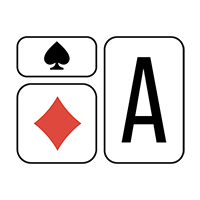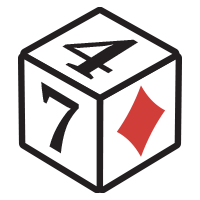Here's Bencb's final analysis on his massive GG Millions victory, but if you want to see the lead-up, just look at Part 1 and 2 below.
Check out Part 1:
Check out Part 2:
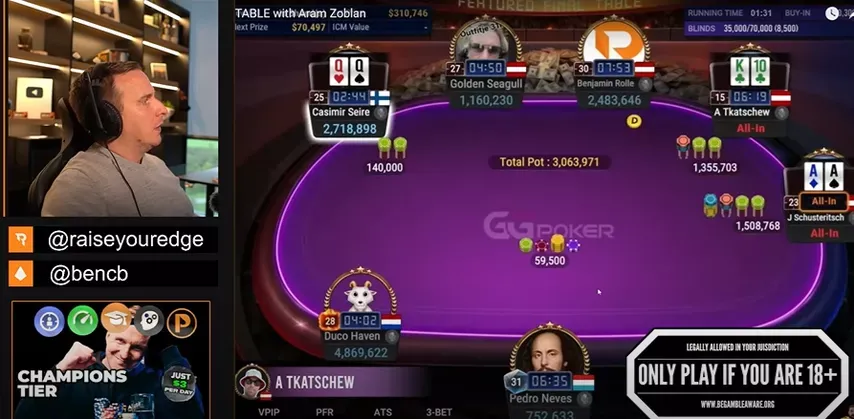
Here, I think rejamming is totally fine. The occasional fake tank with aces—totally fair. I wouldn’t fold queens either. I think queens is the bottom, right? Because he’s rejamming super wide. Schusteritsch can still be on nines-plus, tens-plus. Yeah, just a cooler for Casimir. Aces win.
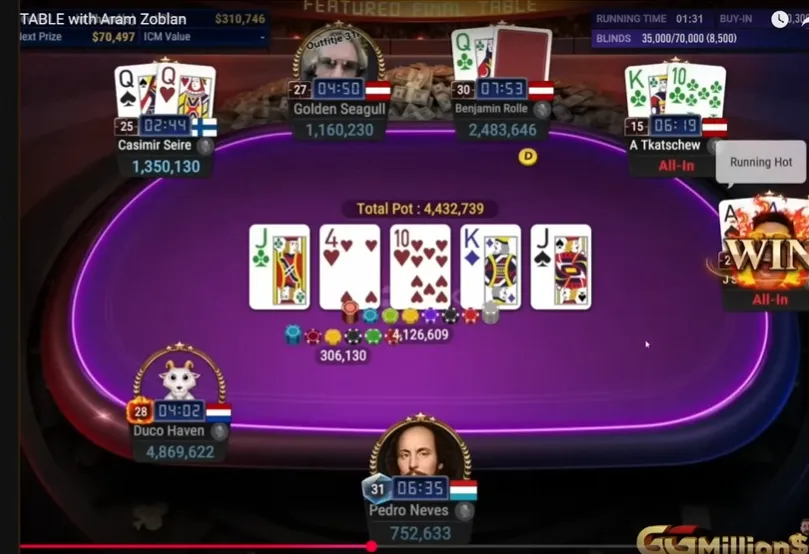
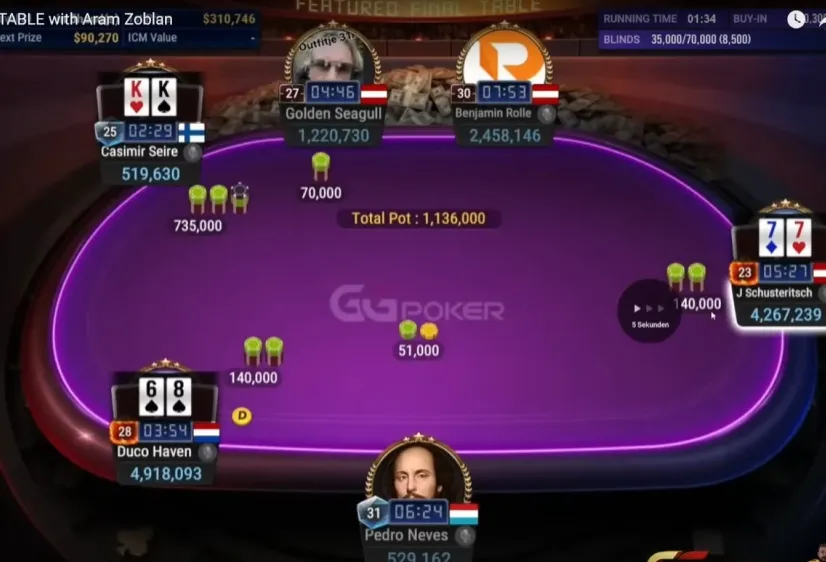
I like the call with six-eight suited. I think this is what Duco is really good at: identifying spots where people have to play tight against him. Schusteritsch has to check so many boards out of position—just folds it, which I think is also pretty solid.
Of course, both fold to Casimir's squeeze.
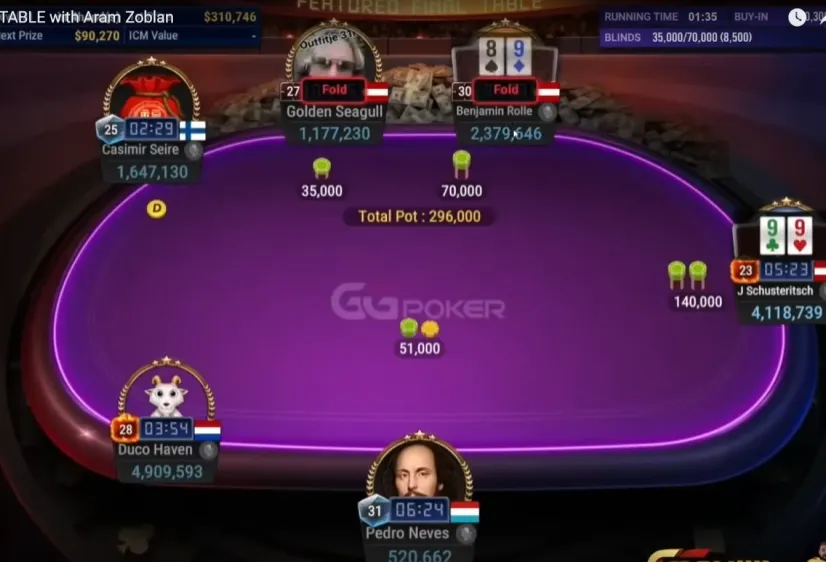
Schusteritsch with nines. Yeah, we see queen-ten fold on the button, which I also think is the right play. And we just fold nine-eight off here against the chip leader. I would also fold ten-nine. I think the worst ten I would call here would probably be king-jack off and king-ten off if I think I have a good postflop edge. Might make it very player-dependent.
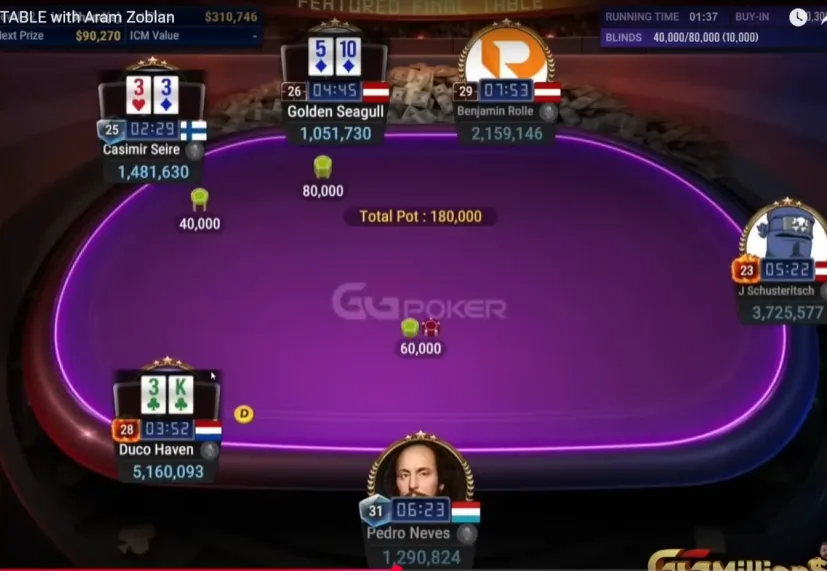
Yeah, he just rips in the king. He has to be careful—very, very careful. These jams are not as good as they look because there’s no immediate short stack, meaning everyone—including me—can be a lot looser compared to when there’s, let’s say, a five or six big blind short stack. But that’s not the case here, so you have to be very, very careful.
Here, on an all-in, both fold, Duko takes the pot.
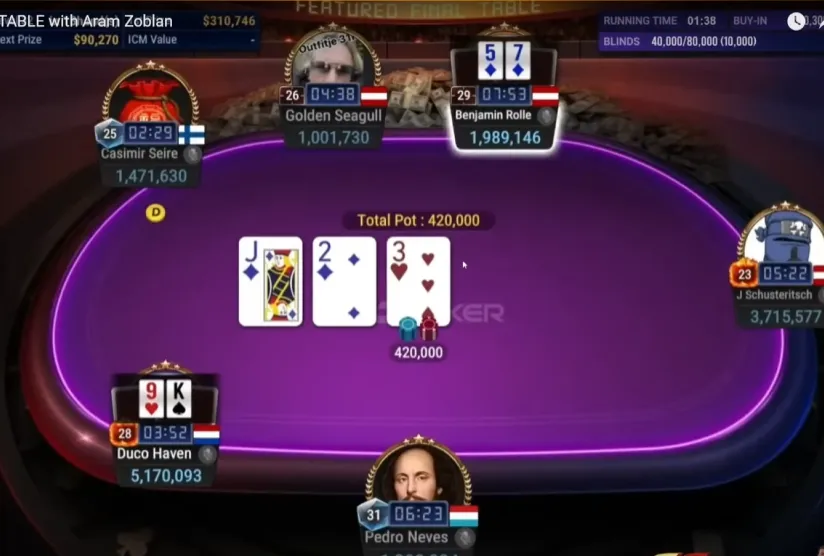
King-nine off—yeah, check-calling the 75%. My plan for the turn was to check-jam if he barrels. I think it’s a good spot for me. And yeah, river is a seven high—we have to bluff. I mean, the four is kind of good, improves some four-fives, six-five floats, some ace-five, ace-fours. And now it’s really just busted flush draws that we bluff with—showing in the five of diamonds.
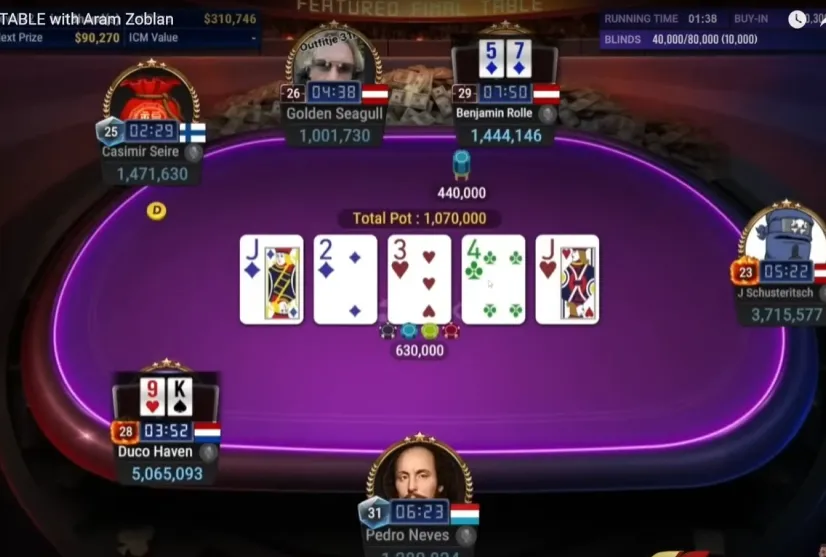
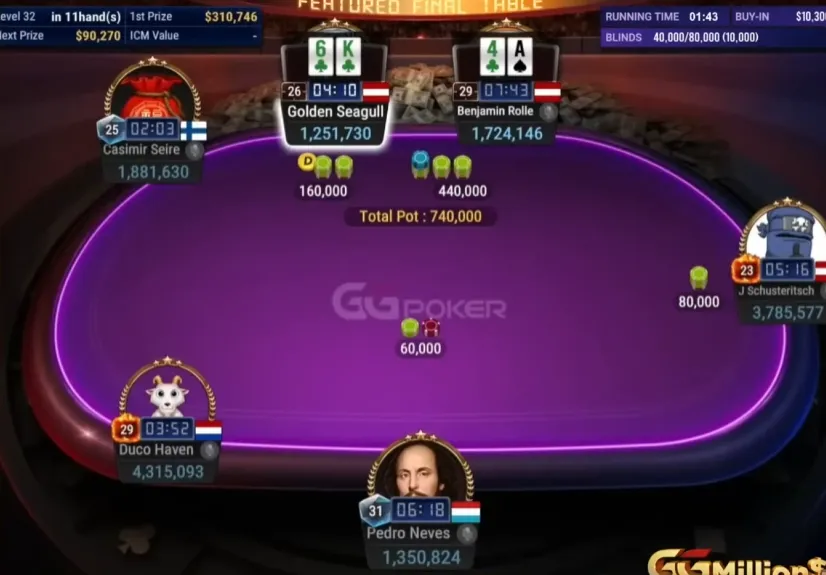
King-six… alright, we go again. And Mr. Golden Seagull. And this is again also—I’ve seen that he did… I see it… did I see it? I’m actually not sure. But even if I saw it, I think it’s still a good 3-bet. Because I think he would not expect me to go light after him. I mean, it’s not even light. It’s a good 3-bet.
So let’s have a look here in this spot—how Button is supposed to play. From smaller than Button… So Button is supposed to have some open jams—it makes a lot of sense. These pairs, some suited aces. And I also think this is a spot where probably people are opening way too many of the aces. That’s why I really like to be aggressive here—even if my hand is not supposed to 3-bet.
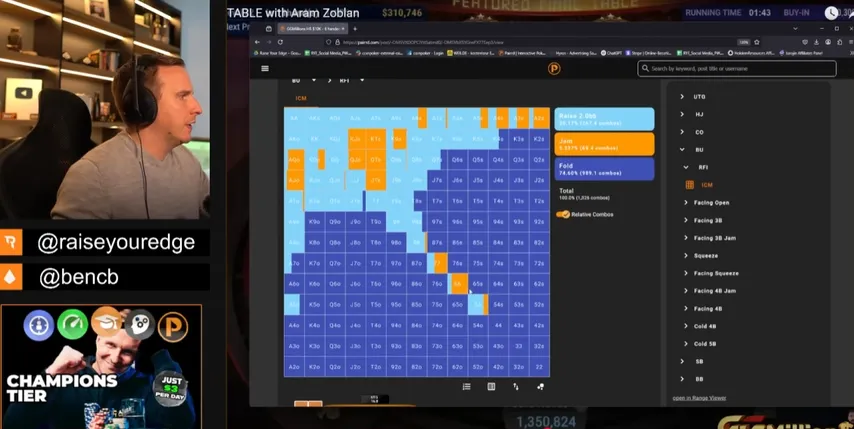
I just think that people here aren't so disciplined—folding 50% of the time in all suited A-x combos. There's no immediate short stack, and you can see, you have to be very disciplined. I mean, folding hands like K9 offsuit or 87 suited—I think most people still include those in their opening ranges.
Now, as you can see, we’re supposed to be bluffing a decent amount of offsuit aces—A4 is in there. But again, I think it’s totally fine to just 3-bet that every single time against the average regular, even at lower stakes, to be honest. We’re shoving some suited aces, that’s orange. It’s interesting—like, pocket eights want to call a little bit, but really doesn’t like flatting here.
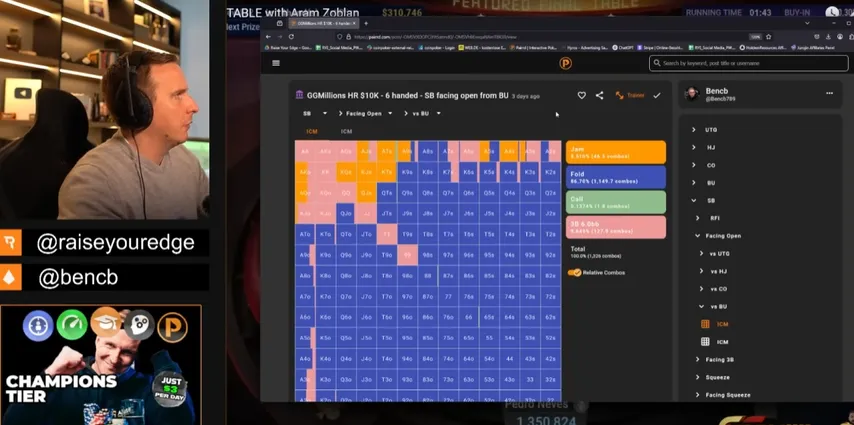
Honestly, I also think against the population, it’s really good to rejam those lower pocket pairs. And if the small blind or button open-jams, we’re calling eights plus. You really see that if you rejam, you block a lot of raise-folds from the 8x combos—like A8, K8, Q8—so pocket eights isn’t as strong as it looks. Even sevens, they’re just not strong enough anymore for flatting or reshoving.
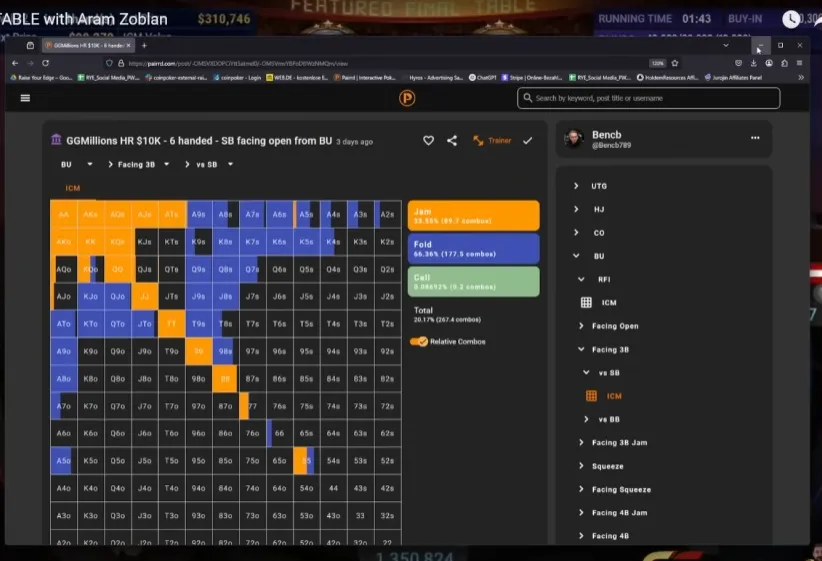
So yeah, I would definitely reg-jam here. It’s very profitable. And you see why the solver wants to do certain things in theory.
Now let’s take a look at how the button is supposed to react to a 3-bet here. And yeah, technically he’s supposed to 4-bet jam basically every pair, KQ, AT suited. Honestly, now him tanking with K6 suited—even though he might be opening more—I think he’s probably forward-jamming every single suited ace. So it might not be as good as it looks. On one side, I face a wider button opening range, but also a more aggressive 4-bet jamming range. So it kind of ends up balancing out—slightly profitable, just as it is in theory.
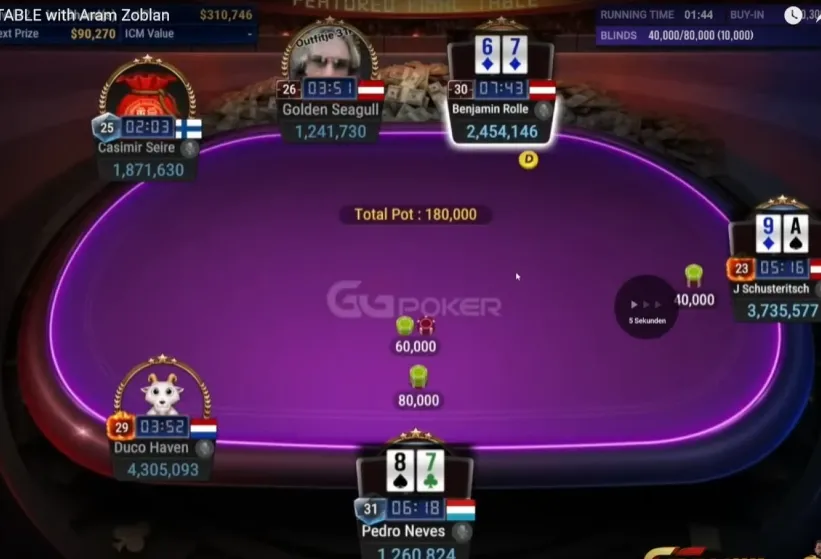
76 suited—we min-raise, and he just gets good hands. But here’s also a big leak I know many players have. Like, “Oh, he’s so aggressive, I should do something.” But with 76, he’s supposed to be aggressive! He’s supposed to be 3-betting almost every single offsuit ace and flatting suited connectors. Even then, very often.
I also teach this in the ICM section—we’re still raising a lot and still over 40%. This is still a profitable strategy. The problem is: you don’t know that. And not knowing this—this lack of information—creates uncertainty, insecurity... biggest friends of tilt. That’s why you tilt.
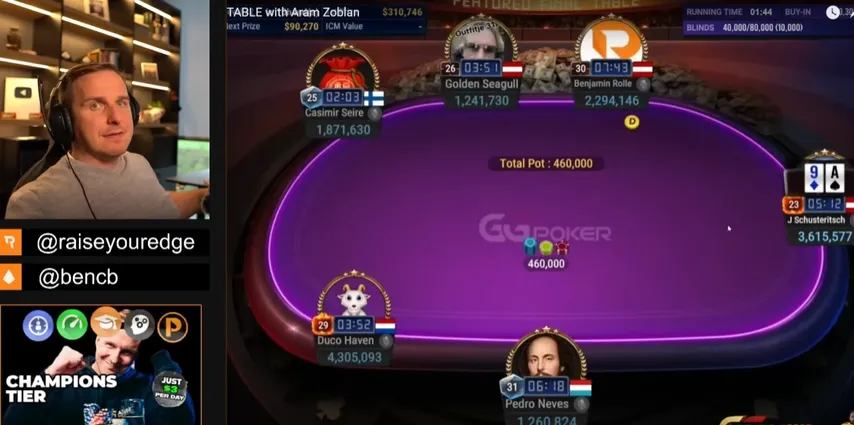
Let’s look at how we’re supposed to play button vs. small blind. As you can see, the button is still opening relatively wide. I think it’s still pretty decent, especially with three shorter stacks—we’re opening almost 30% of hands, nearly every offsuit broadway.
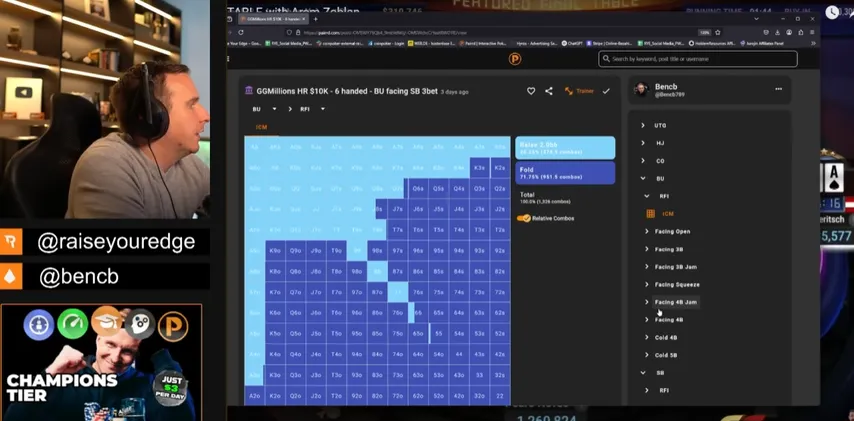

Potentially interesting spot. We have a fold here, of course, because there is a short stack with nine blinds at the table. I would call with AJs+. Although Duko shoves quite wide, and I will often dominate him with ATo, calling would be bad ICM-wise.

Ace-Ten with pocket fours, I would call fives or better. Or sixes. Sixes, at least. Probably five and better, I would call and just go and Seagull is out.
I think PA actually played pretty well—quite aggressive, made some good adjustments.
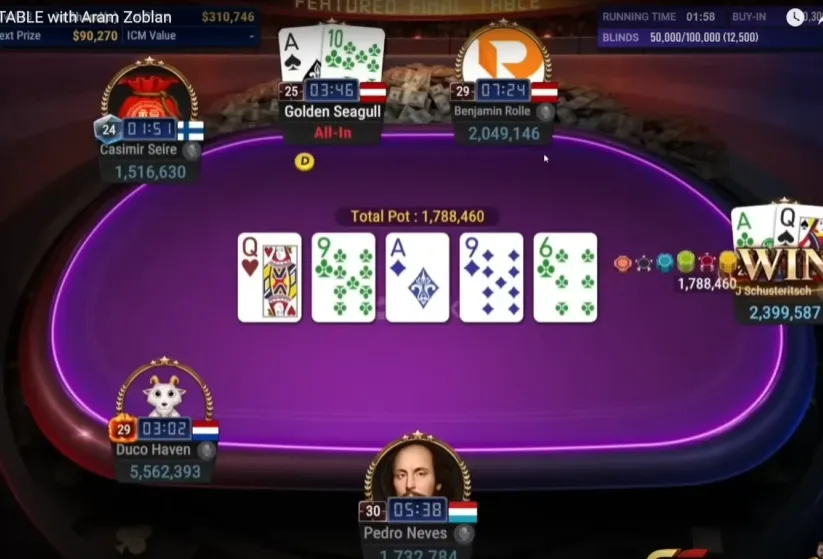
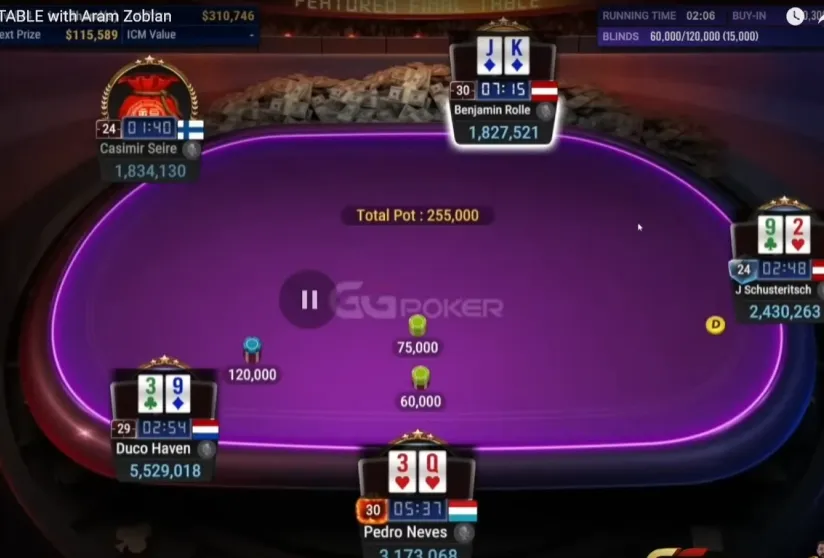
We also have a nice open jam. On some tables I would just min-raise and then fold, but we’ve seen that they’ve been a little more aggressive with three-betting, not necessarily re-jamming. So I think it’s actually better to min-raise and then four-bet jam against a small three-bet.
Now that I know how they play—that they’ll be aggressive with both three-bets and re-jams—this is a hand that would be quite bad to raise/fold in an aggressive lineup.
- GipsyTeam's unique promotions
- Help with deposits and cashouts
- Access to private freerolls
- Round-the-clock support
- GipsyTeam's unique promotions
- Help with deposits and cashouts
- Access to private freerolls
- Round-the-clock support
- GipsyTeam's unique promotions
- Help with deposits and cashouts
- Access to private freerolls
- Round-the-clock support
- GipsyTeam's unique promotions
- Help with deposits and cashouts
- Access to private freerolls
- Round-the-clock support
- GipsyTeam's unique promotions
- Help with deposits and cashouts
- Access to private freerolls
- Round-the-clock support
- GipsyTeam's unique promotions
- Help with deposits and cashouts
- Access to private freerolls
- Round-the-clock support
- GipsyTeam's unique promotions
- Help with deposits and cashouts
- Access to private freerolls
- Round-the-clock support
- GipsyTeam's unique promotions
- Help with deposits and cashouts
- Access to private freerolls
- Round-the-clock support
- GipsyTeam's unique promotions
- Help with deposits and cashouts
- Access to private freerolls
- Round-the-clock support
- GipsyTeam's unique promotions
- Help with deposits and cashouts
- Access to private freerolls
- Round-the-clock support
- GipsyTeam's unique promotions
- Help with deposits and cashouts
- Access to private freerolls
- Round-the-clock support
- GipsyTeam's unique promotions
- Help with deposits and cashouts
- Access to private freerolls
- Round-the-clock support
- GipsyTeam's unique promotions
- Help with deposits and cashouts
- Access to private freerolls
- Round-the-clock support
- GipsyTeam's unique promotions
- Help with deposits and cashouts
- Access to private freerolls
- Round-the-clock support
- GipsyTeam's unique promotions
- Help with deposits and cashouts
- Access to private freerolls
- Round-the-clock support
- GipsyTeam's unique promotions
- Help with deposits and cashouts
- Access to private freerolls
- Round-the-clock support
- GipsyTeam's unique promotions
- Help with deposits and cashouts
- Access to private freerolls
- Round-the-clock support
- GipsyTeam's unique promotions
- Help with deposits and cashouts
- Access to private freerolls
- Round-the-clock support
- GipsyTeam's unique promotions
- Help with deposits and cashouts
- Access to private freerolls
- Round-the-clock support
- GipsyTeam's unique promotions
- Help with deposits and cashouts
- Access to private freerolls
- Round-the-clock support
- GipsyTeam's unique promotions
- Help with deposits and cashouts
- Access to private freerolls
- Round-the-clock support
- GipsyTeam's unique promotions
- Help with deposits and cashouts
- Access to private freerolls
- Round-the-clock support
- GipsyTeam's unique promotions
- Help with deposits and cashouts
- Access to private freerolls
- Round-the-clock support
- GipsyTeam's unique promotions
- Help with deposits and cashouts
- Access to private freerolls
- Round-the-clock support
- GipsyTeam's unique promotions
- Help with deposits and cashouts
- Access to private freerolls
- Round-the-clock support
- GipsyTeam's unique promotions
- Help with deposits and cashouts
- Access to private freerolls
- Round-the-clock support
- GipsyTeam's unique promotions
- Help with deposits and cashouts
- Access to private freerolls
- Round-the-clock support
- GipsyTeam's unique promotions
- Help with deposits and cashouts
- Access to private freerolls
- Round-the-clock support
- GipsyTeam's unique promotions
- Help with deposits and cashouts
- Access to private freerolls
- Round-the-clock support
- GipsyTeam's unique promotions
- Help with deposits and cashouts
- Access to private freerolls
- Round-the-clock support
- GipsyTeam's unique promotions
- Help with deposits and cashouts
- Access to private freerolls
- Round-the-clock support
- GipsyTeam's unique promotions
- Help with deposits and cashouts
- Access to private freerolls
- Round-the-clock support
- GipsyTeam's unique promotions
- Help with deposits and cashouts
- Access to private freerolls
- Round-the-clock support
- GipsyTeam's unique promotions
- Help with deposits and cashouts
- Access to private freerolls
- Round-the-clock support
- GipsyTeam's unique promotions
- Help with deposits and cashouts
- Access to private freerolls
- Round-the-clock support
- GipsyTeam's unique promotions
- Help with deposits and cashouts
- Access to private freerolls
- Round-the-clock support
- GipsyTeam's unique promotions
- Help with deposits and cashouts
- Access to private freerolls
- Round-the-clock support
- GipsyTeam's unique promotions
- Help with deposits and cashouts
- Access to private freerolls
- Round-the-clock support
- GipsyTeam's unique promotions
- Help with deposits and cashouts
- Access to private freerolls
- Round-the-clock support
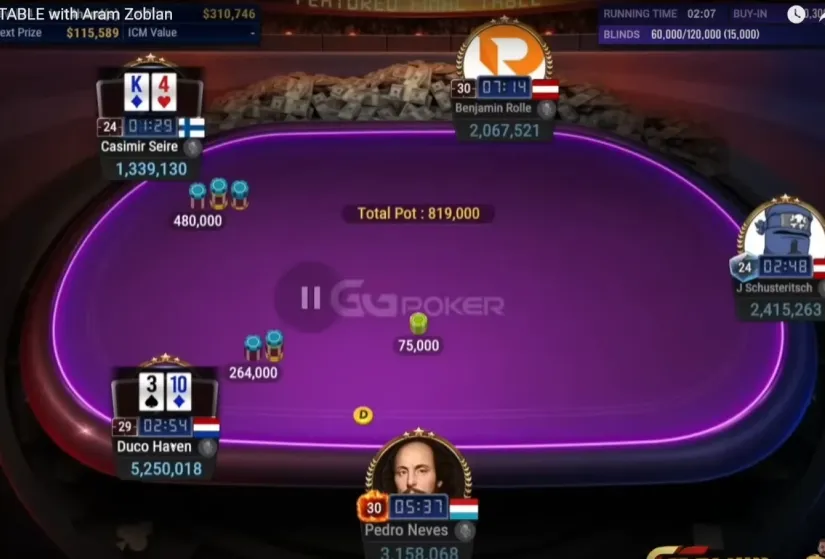
Casimir here makes a really well-timed three-bet. Not sure if I’d do this, but this is what I mean: look at the lineup. Casimir’s in a spot where he has to defend really wide. There’s no short stack—we’re five-handed. It’s worth spicing it up, but I think this is not a good open-raise.
This is the typical spot where someone thinks, “I have a lot of chips, I want to apply pressure.” But his player profile doesn’t allow it. He’s not tight. He’s not a nit. He’s solid-aggressive. And in theory, I don’t think you want to be vpipping this wide. I mean, if you open 10-3 offsuit, then pretty sure he’s playing close to any two cards.
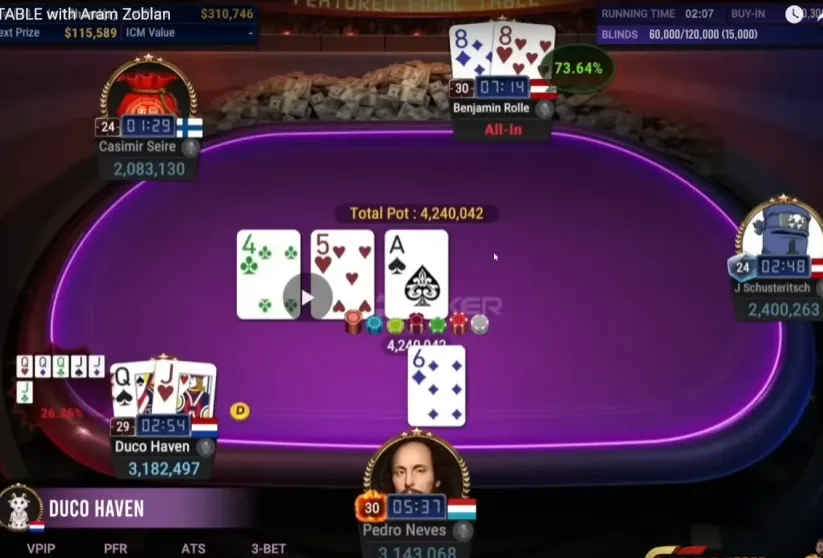
That was a big one.
Now we’re in a spot where we call sevens-plus and just hope to hold—or better yet, run into Ace-3, pocket fives, or pocket sixes. Even though all of those would’ve had me beat, I’m still okay with it. In this case, he had Queen-Jack, and obviously from an EV standpoint, we need to win those flips.
We win a big one here.
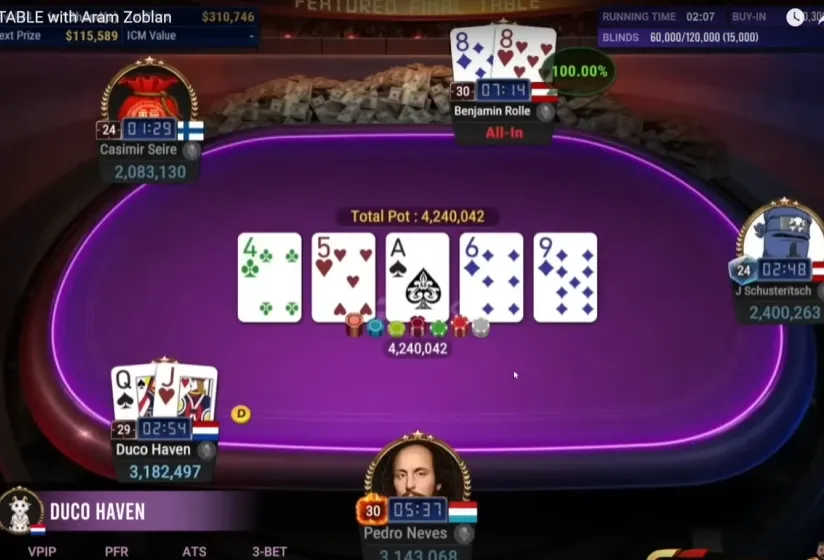
I min-raise from the cutoff with KQs. Duko in the BB defends 76o – a mistake in my opinion.
On the flop I have a standard continuation bet with my entire range. Duko check-raises, which is a very strange, illogical decision.
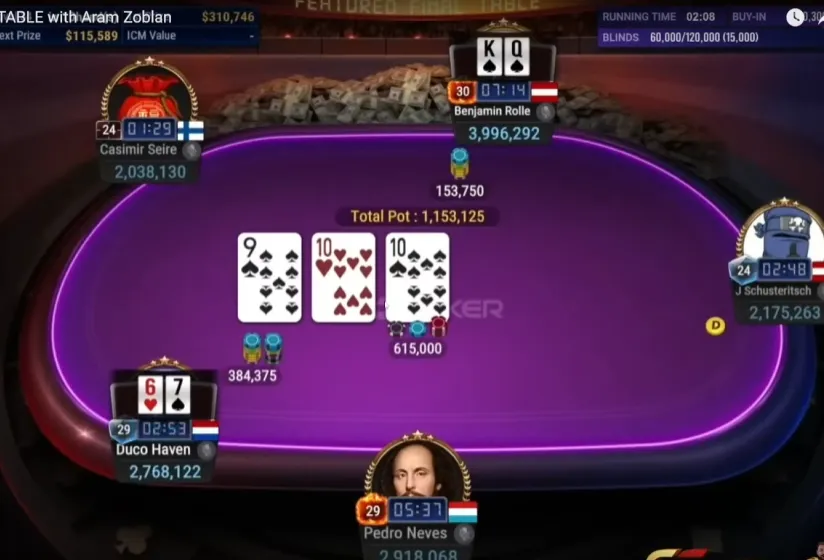
King-Queen—good defense from the big blind, but I don’t like the defend. I don’t think it’s a good defend, especially now against a bigger stack.
We c-bet wide with our entire range here on this board. The good thing is, we’re going to have a decent amount of offsuit 10x. He goes for a weird check-raise. Doesn’t make any sense to re-raise, so we just call. On the turn, we just check back. No need to bet—we’ve seen he’s capable of fancy plays. Remember the sevens? Fancy doesn’t mean bad, just saying—he has some tricks up his sleeve.
Then on the river, he bets. I think we beat too much. He’s still going to have Jack-8, 7-8, 7-6, Queen-Jack. So I just close my eyes and click the call button—and yeah, we win another decent pot.
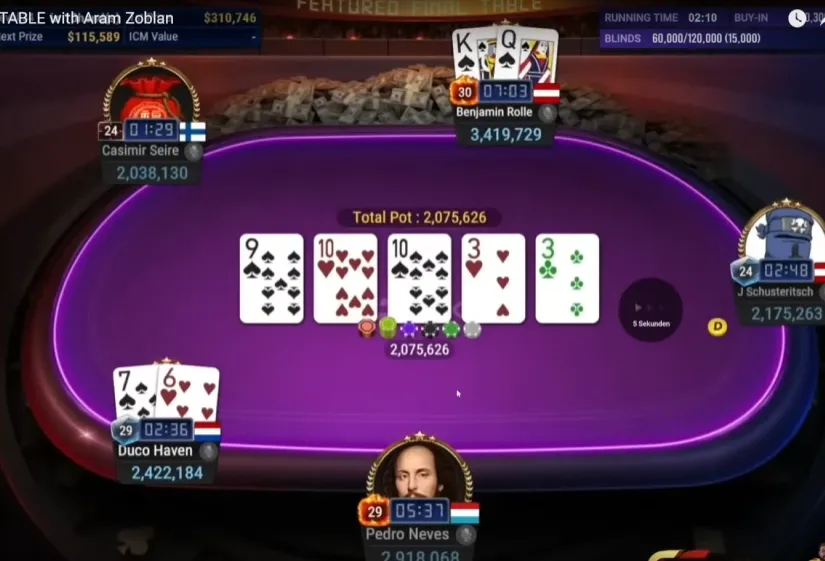
I don’t like the sizing here—just min-raising gives too good of a price. Also, when you size down, it gives Casimir less incentive to re-jam. If I actually have Ace-2 suited now, I might just call when he 3xes, or at least if he goes 2.5x—it’s just so much more appealing to re-jam.
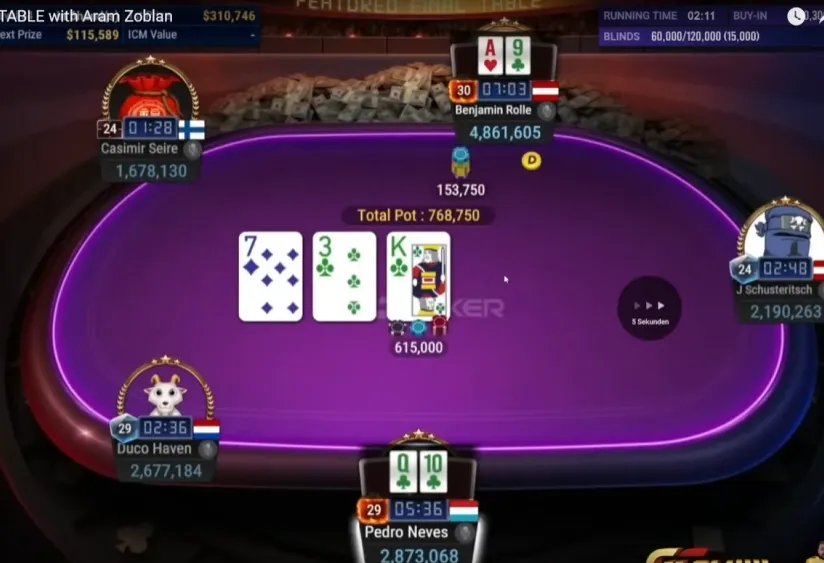
Ace-9 offsuit—easy open.
We c-bet, and this is a really good card for our barreling range. A lot of our Queen-high bluffs—Queen-Jack, Queen-10, Queen-Deuce—improve. Jack-high hands also gain equity—Jack-9, Jack-10—it connects with the seven.
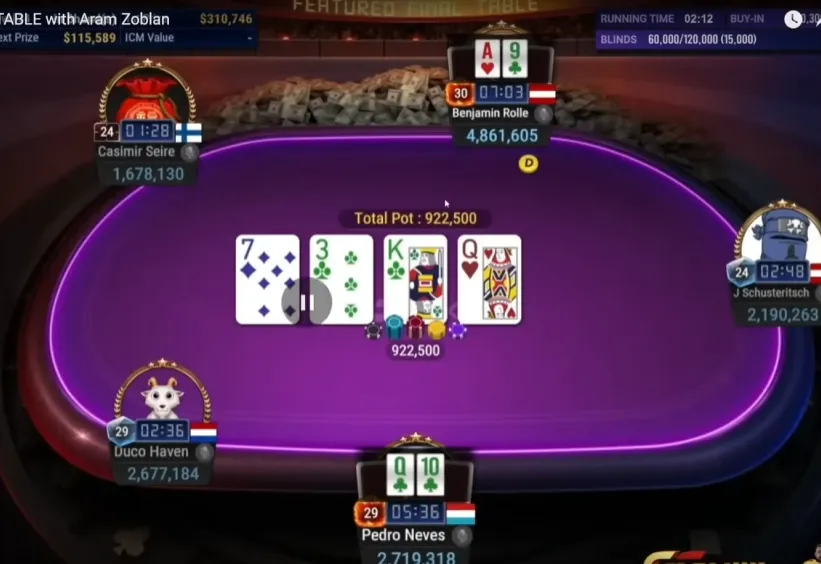
Definitely want to be really aggressive here. We can basically value bet any King. If he has 7x with clubs, Queen-x with clubs, or Ace-high flush draws—he didn’t raise the flop, so we still have more King-x.
But I decided to check the turn. I don’t think it’s bad, but I would’ve liked to see a second barrel—especially when you block hands like 7-9 of clubs or Queen-9 of clubs. It’s always good to have a club in hand—it makes it more likely that he has something like 7-6 in hearts.
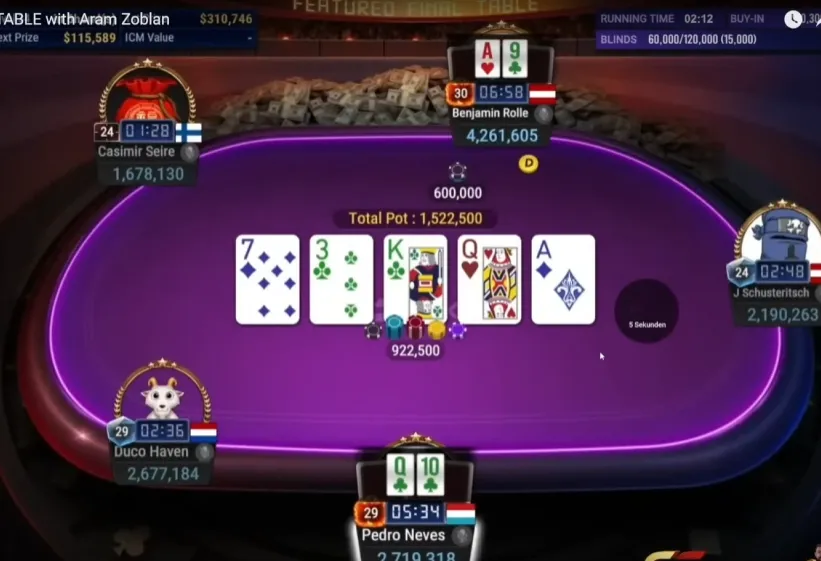
River comes—we value bet—and he tanks for a long time. He might’ve even considered check-jamming the river. That would’ve been dicey. But I think we just get the call often enough.
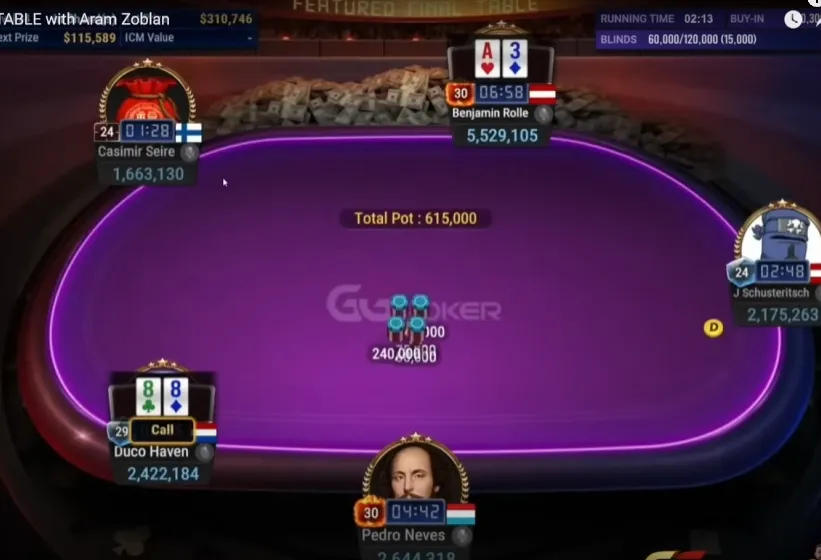
This spot was really, really interesting. Against a wide cutoff range from the chip leader, you just rip it in. If it’s a tight 20–30 BB range, okay, I can see calling—you make a lot of EV postflop. But against a really wide range, you lose too much EV just calling and letting me realize my equity. So I was surprised to see him call.

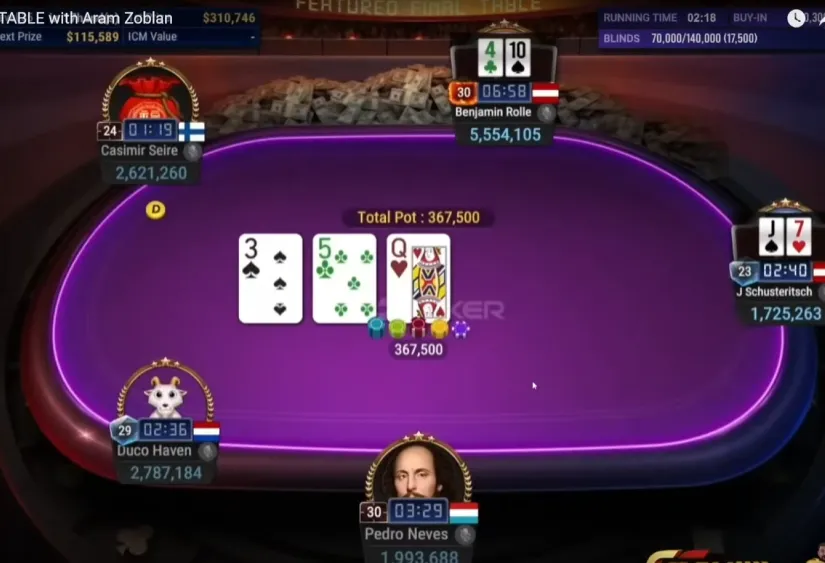
Here, my intention was—I think again, we just give up. Obviously, I want to VPIP 100%, but also I’m more mindful that Schusteritsch is now the shorter stack. He’s shown a lot of aggression. I don’t think he’s money scared or anything, so I can’t just go ahead and raise 10-4 offsuit, 9-3 offsuit, 10-Deuce offsuit. My range is going to be way out of line.
I’m going to have some limps. I just try to be mindful. And sometimes in these spots, when you’re playing against the best of the best and they know how to defend and play this stuff, then I’ll also get a little bit closer to GTO. But again, this does not apply to 99% of players—unless I have a reason to believe he overfolds his big blind, I’m not raising. I don’t have that read, so I’m not doing it.
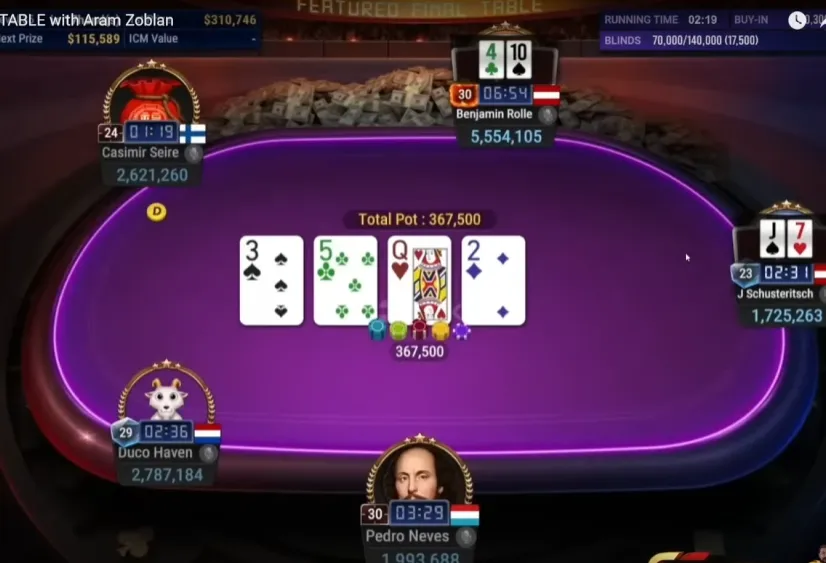
Turn—I wanted to go for the check-raise. That was the plan. I think a lot of cards like Three, Five, Deuce interact with his check-back range a lot. He’s going to have hands like 9-Deuce, 7-3. He might take a stab against my Ace-high, because I’ll improve to a lot of Ace-highs.
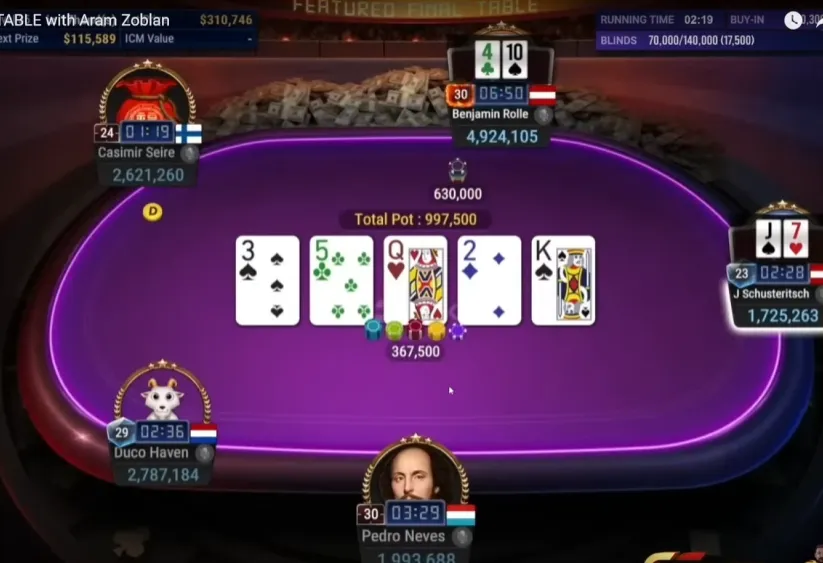
Now, the river—I represent a lot of King-highs. Let’s check it down. I also expect he’s still going to have 3-Deuce, 4-Deuce, 4-3, 4-5, 6-5, 10-Deuce. I think he’s checking back—he would bet something like 6-Deuce, 6-3, because he needs more protection. But he’s still going to have Jack-Deuce—that’s still close to a Queen. So I think betting small isn’t good. Obviously, you just fold out Jack-highs—not a lot of combos. Of course here, it would’ve worked, but I think in this spot you either bet a third, just try to fold out even Nine-highs that might bluff you out of the pot, or you go really big and apply pressure against 10-5, 10-3, Jack-Deuce.
That was my plan here. And I mean, whatever I do, he would’ve folded.
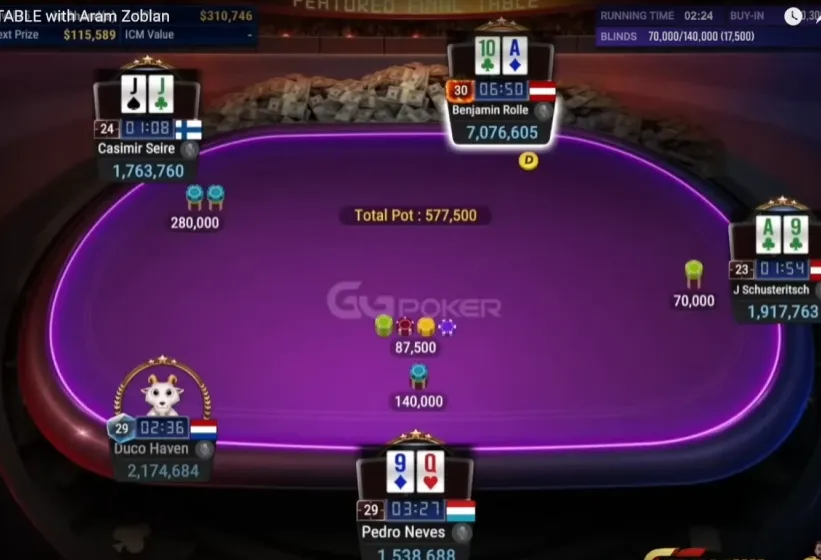
That was also an interesting spot. Here, I decided to jam, and I wasn’t sure if it was actually that good. With the Ten, again, we block a lot of raise-folds. Maybe it’s just a flat. Maybe it’s just a small three-bet fold.
He raises off what, 14.5 big blinds? Let’s take a look. Obviously, he’s going to have push-all-ins and raises. We see here—he raises King-Ten offsuit, Ace-Ten offsuit, Jack-Ten suited, Queen-Ten suited. All of these are raise-folds. So having a Ten might not actually be so good. We block the Tens, but we also block more folds.
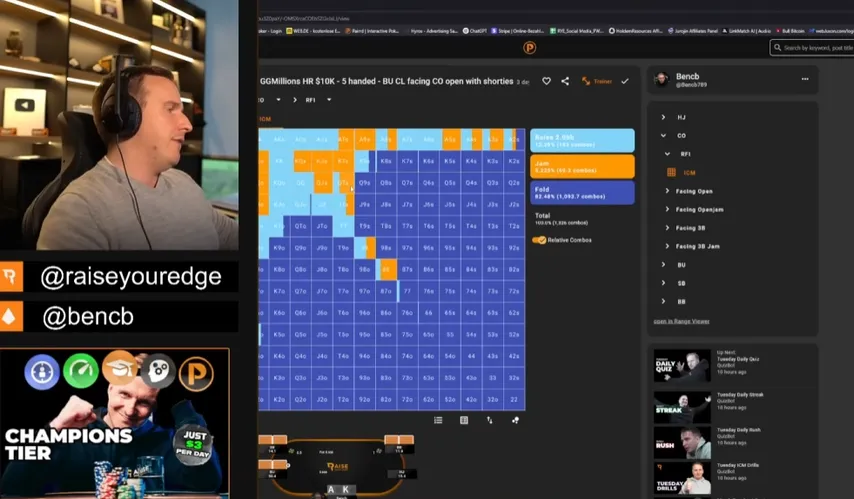
This is the blocker dynamic—yes, we block value, but he already has 12 combos of Ace-Ten offsuit. Then King-Ten offsuit, a little bit of Jack-Ten, Queen-Ten suited. So yeah, I'm very curious about this spot. And you see I’m reviewing these spots, even when I re-jam and get called. I don’t care if I win or lose. I see a lot of you guys posting in our Discord and only posting hands when you lost. That’s so results-oriented, and it’s really, really bad.
Ace ten offsuit—that’s just a call. We just flat.
You see that if we want to bluff or three-bet something, it wants to three-bet these offsuits. You just see the EV of suited Aces because of their suitedness.
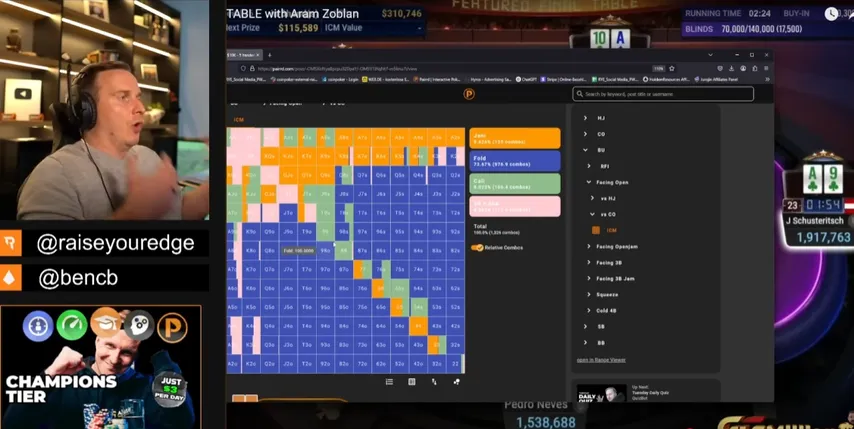
But actually, the amount of suited Kings it wants to jam here—just unblocking all of these Ace-x raise-folds—is absolutely crazy. It even likes jamming those lower pairs more than these middling pairs. It likes to call those because you dominate so much of their range. And you still block a lot of folds—you block King-Nine, Ten-Nine suited, Queen-Nine suited, Ace-Nine offsuit, etc.—same with the A8x. And then it starts getting the money with Tens, because now it's for value—he’s going to stack off Nines and Eights.
So very interesting, always, these ICM dynamics with blockers. And I think it's still a profitable jam for sure. I mean, if it wants to jam King-Ten offsuit, right—and you see King-Ten offsuit is more profitable to jam than Ace-Ten offsuit—because with King-Ten, at least you unblock all the Ace-x raise-folds. And with a King, you block the same amount of value as with an Ace—you block Aces, you block Ace-King. With Kings, you block Kings and Ace-King. So obviously, Ace-Ten offsuit has the added benefit that you have an overcard to Kings.
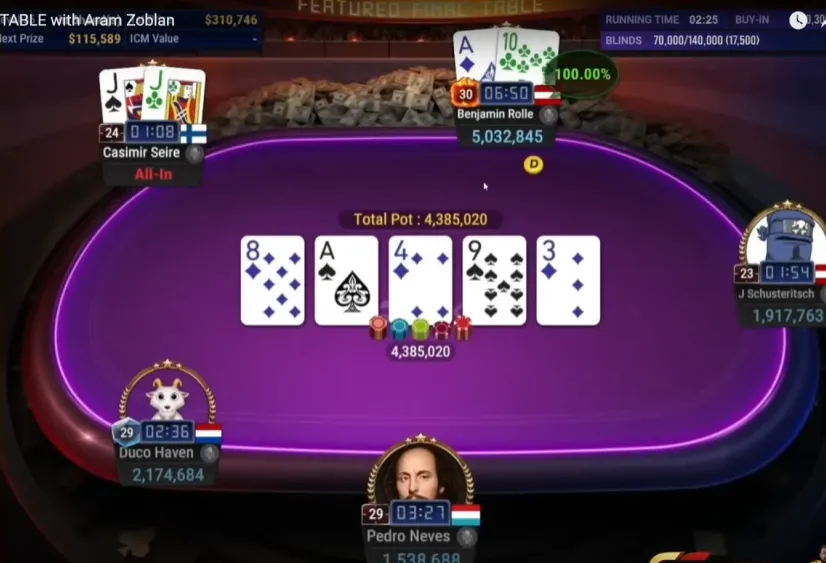
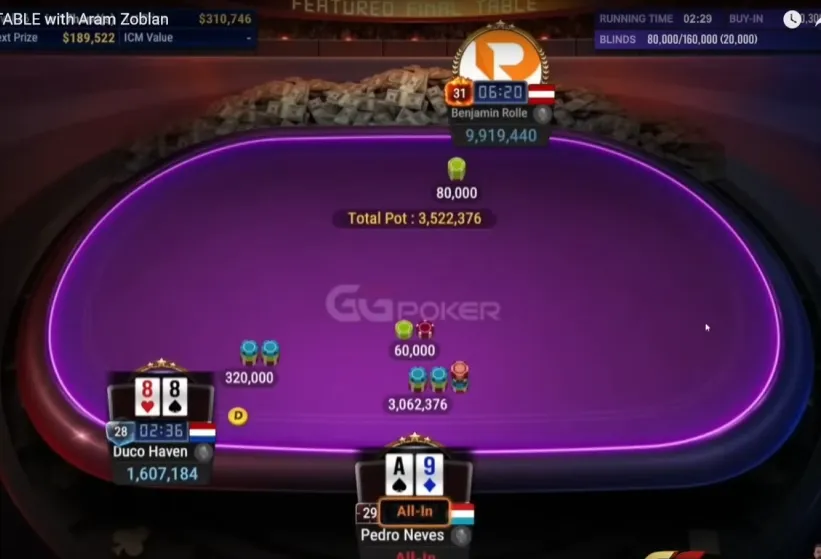
Pocket Eights—I also think this is a spot where Ace-Nine is probably slightly better as a call. Again, you block raise-folds and you dominate so many hands in his range. Crazy what a comeback he had after losing that huge pot—Ace-Jack against Sevens.
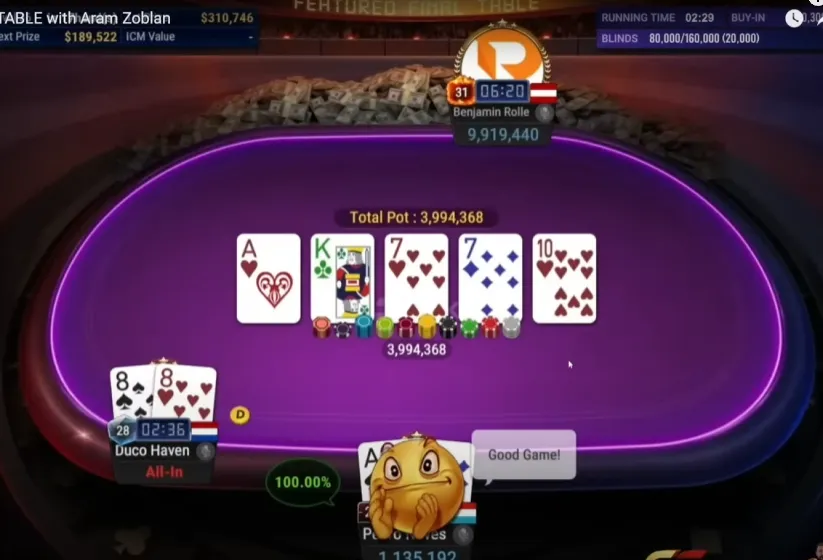
Heads Up Portion
All right, so we locked up $240k. Obviously, I’ve final tabled this now for the 20th time. I’ve only won it once, but I also haven’t been running so well.
So we go into the heads-up match with a 2:1 chip lead. First hand—Kings.
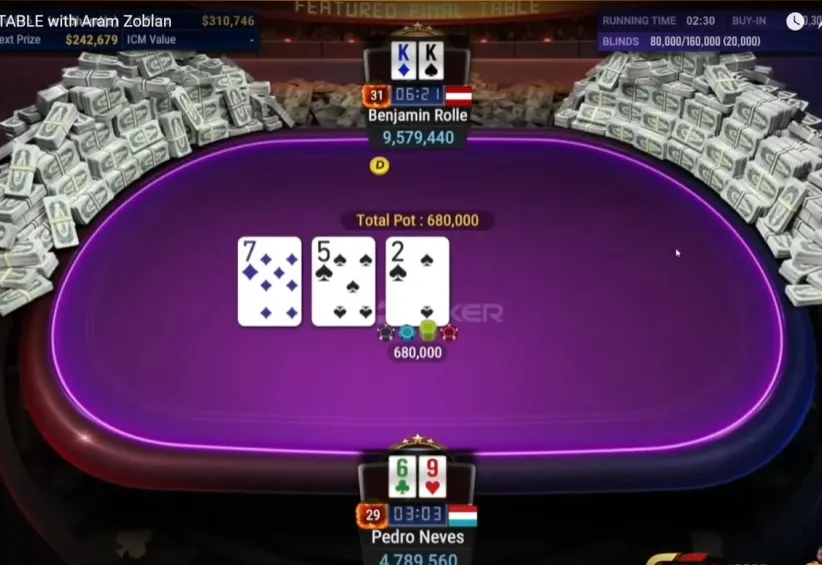
Usually, I would go for bigger sizings here because it's a good board for us. We have a lot of very vulnerable value, but with the King of Spades, I decided to bet small. He only calls, which I think is fine with the gutshot.

On the turn, I’m spicing it up.
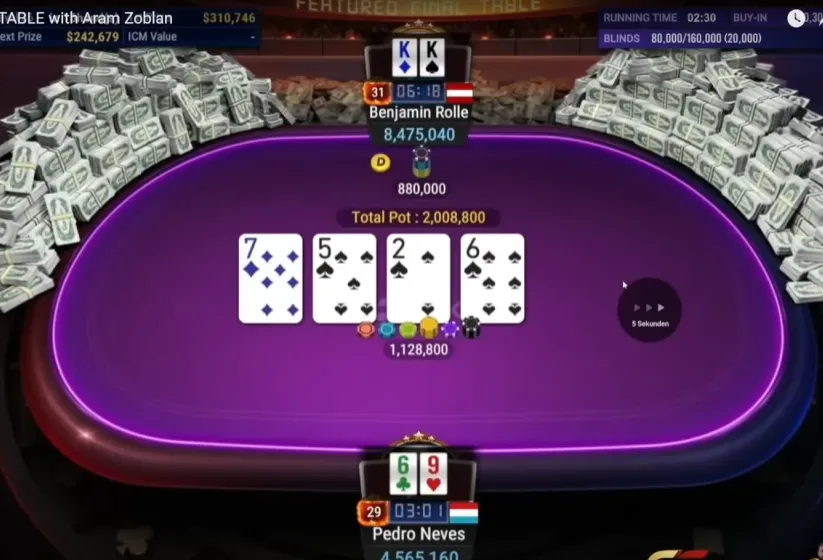
River is the 6. Apart from 6-4, 6-8, and 6-9—and some of those combos also raise the flop, right? So what an overplay. This is a no-brainer value jam on the river. If he has 6-5 or 7-5, he almost always raises the turn. We block a lot of flushes. We unblock all the 7x hands that he gets to the river with.
A lot of the nut flush draws could have been three-bet preflop. Some lower flushes are raising the turn. So yeah, I think heads-up, nobody's folding Queen-Seven. If he has Queen-Seven, Queen of Spades, Jack-Seven, Jack of Spades—I think the heads-up is over. There are very few 6x hands on the river. Very few flushes—maybe like 3-4 of Spades or 9-8 of Spades. But it's just always one hand versus five, six, seven combos of Queen-Seven, same for Jack-Seven, Ten-Seven. So he's having a lot.
I just don’t understand sometimes the comments I see—hey, we can have King-Four, Queen-Four, Jack-Four, King-Eight, Queen-Eight, Jack-Eight, Ten-Eight. We have so many gutshots. So many Queen-Jack, King-Jack with one spade.
If you don’t jam Kings for value here, that means your opponent is massively overfolding—and then you should be bluffing everything. I don’t think that’s the case, so we just jam for value. Obviously, very unfortunate runout—that was unlucky for us.
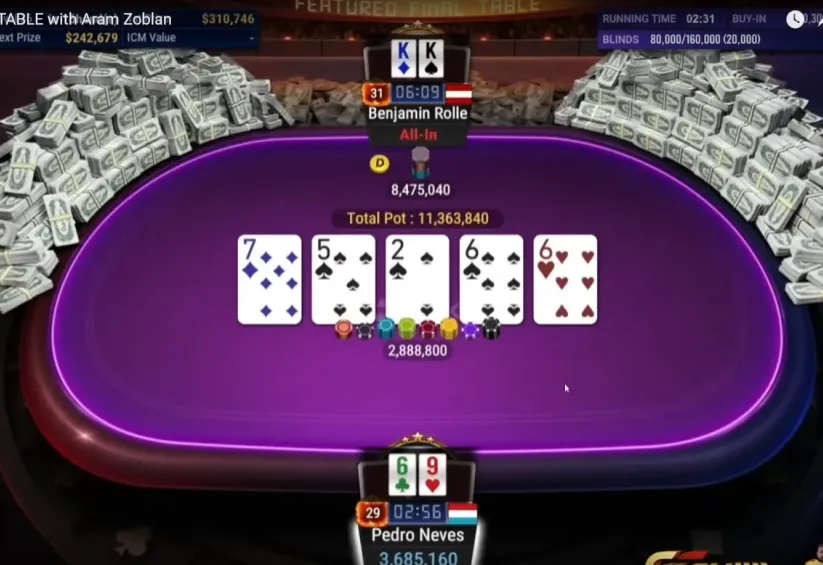
It was a weird match. He was having a bad time, and so was I. It seems like one thing contradicts the other, but our luck was different. I knew he was playing HU too loose, and I tried to call aggressively, but unfortunately he kept getting dealt some wild nuts preflop. My raise-folds and 3-bet-folds may look loose to outsiders, but they were part of an overall game plan that I thought was right.
But I was doing very well in all-ins!
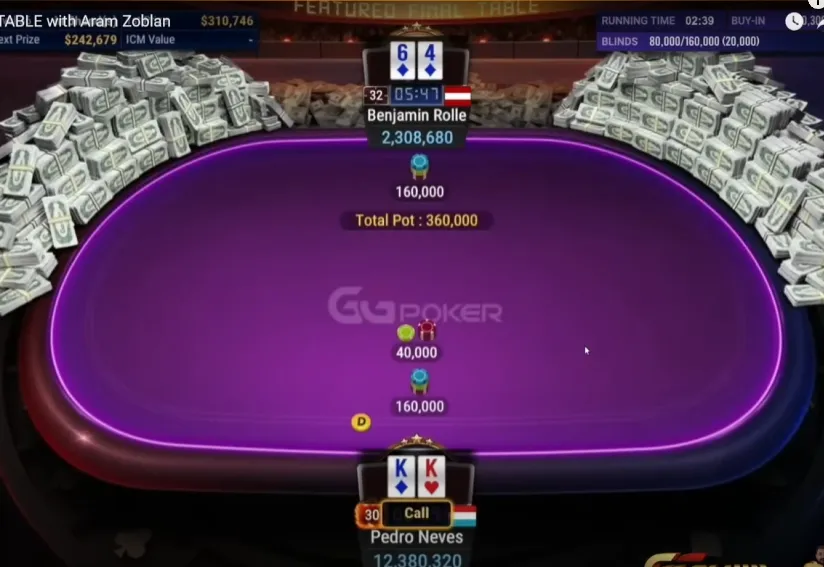
Did he limp? Yeah, he limped.
Now with these stack types, we want to be raising trashy suited combos. Don’t want to raise the Six. We could jam. I think it’d be fine to jam against him, to be honest. What happened here? I wanted to go for a check-raise on the flop. Then I wanted to go for a check-raise on the turn—but unfortunately...
Yeah, so I was like, “All right, I’m still going to have five.”
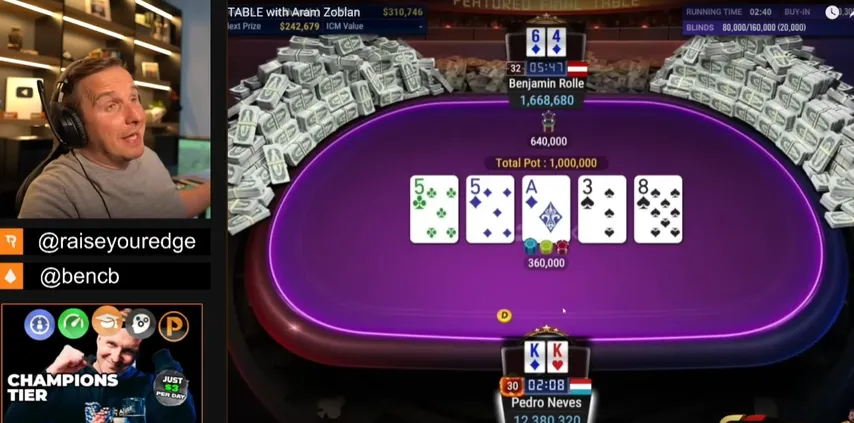
So I go for the overbet. Honestly, I didn’t put him on Kings—I put him on like King-Three, Rivered King-Eight, Pocket Nines… King-highs that, if I bet here, would never fold—but against an overbet, they might decide to let it go. Similar to that blind vs blind hand I had earlier.
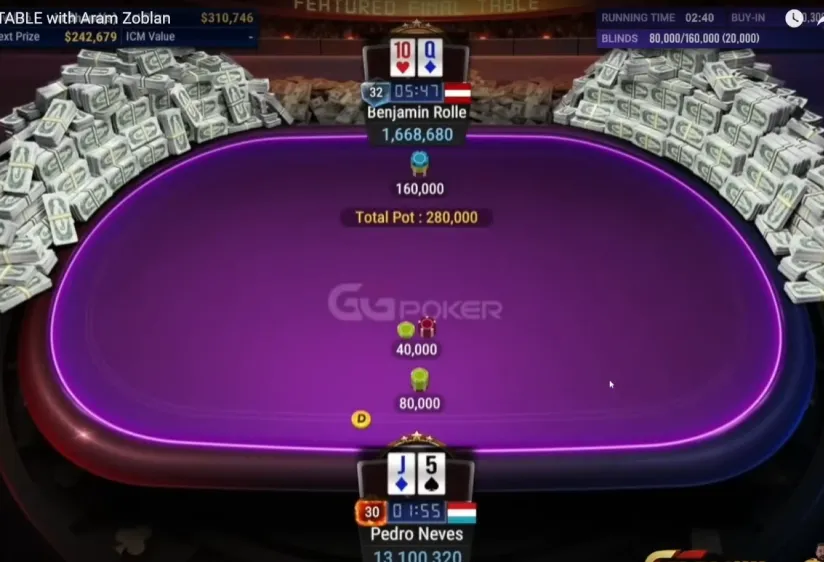
We could jam pre, but again, this hand plays so well postflop against all his junk—even out of position. Especially on Broadway boards like this, we just get so much EV postflop. I think once he bet the turn, I already knew, “Okay, he’s going to be tripling this quite often.” You know—Jack-Five, Jack-Three. But especially with the Five of Hearts, Five of Spades, I think he's overbluffing this spot.
With 10 big blinds, he's shoving a lot of Ace-X, King-X—he doesn't have as much value as he thinks. If he limps Ten-Deuce offsuit, Ten-Three suited—so much garbage. All the offsuit check combos—way too many bluffs. Obviously, I was just making sure I’m not missing anything, but we always call down here.
And yeah, it helped us a little bit to come back—fortunately.
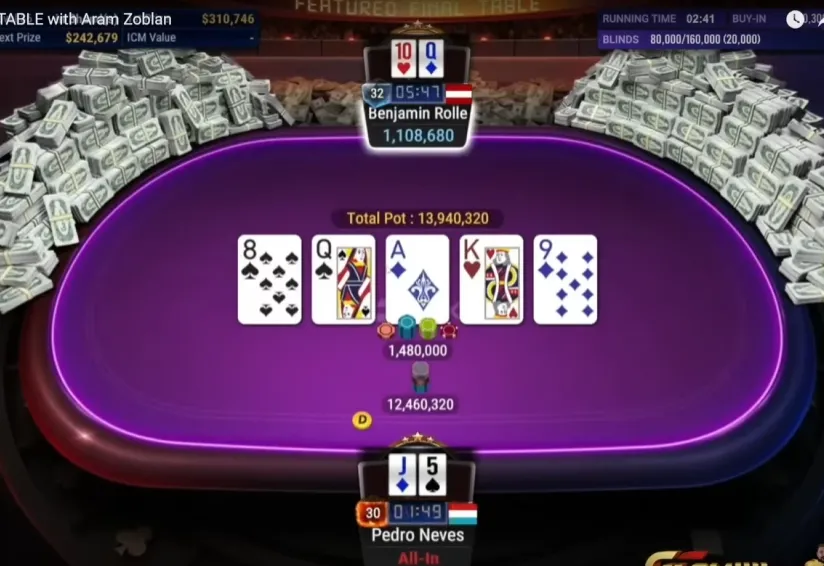
What happened here? Ah—yeah, again, I know he’s just way too aggressive. We saw it with the Queen-Ten suited earlier. Whatever spot he can choose aggression, he’s going to take it.
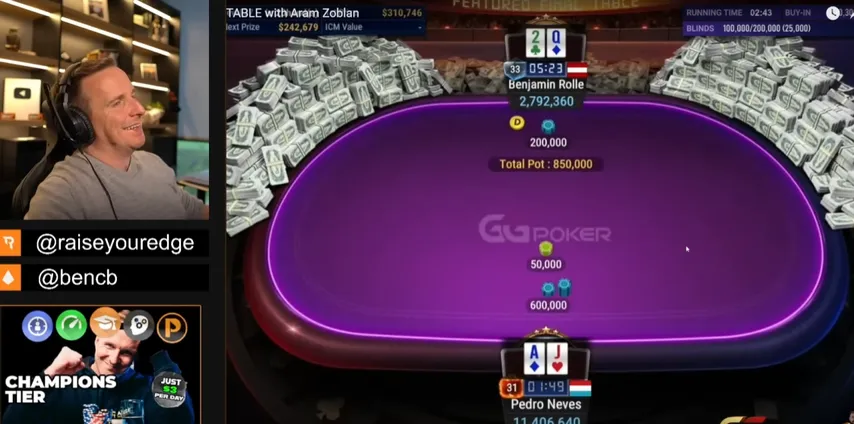
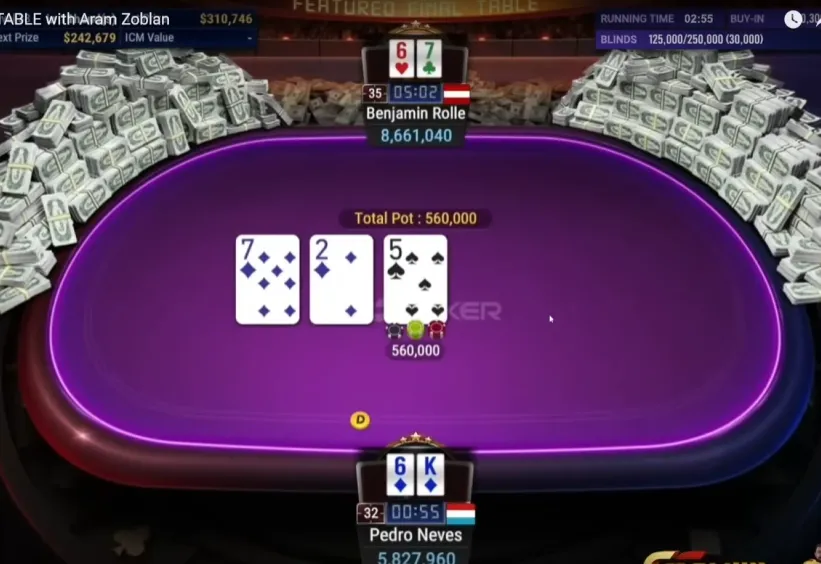
Next hand—he raises King-Six, we check back Seven-Six. Interesting that he checks this back. Obviously, we want to bet the turn.

The Nine is almost like a blank—most 9x bet. So we still have a value bet against the Five, which I think—if he rivers like King-Four or Five—we’ll probably get a call.
Really cool of him to see that—and he rips it in here, especially so quickly. That was sick.
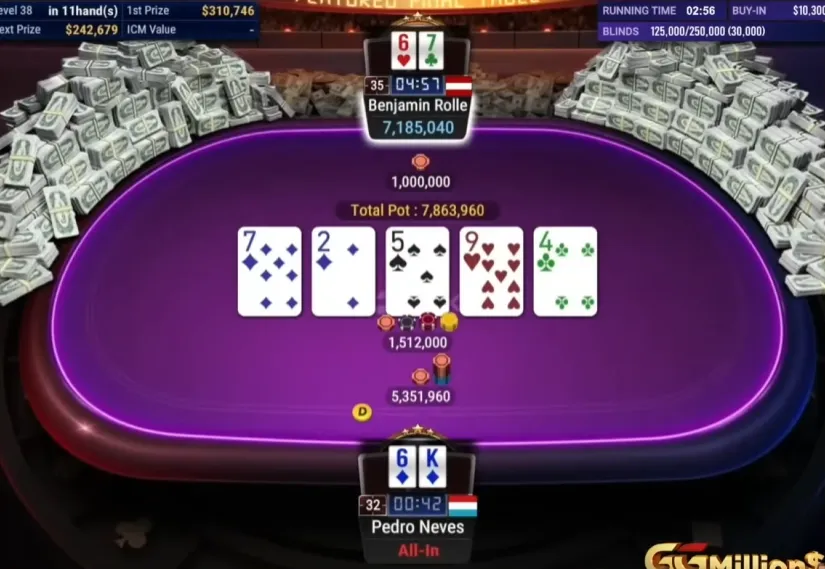
All right, and I think—yes, I block 6-8—but this is very important to understand: you block more bluffs because he’s going to be picking things like 6-2, 6-4. You see—he wants to pick a Six himself to block my straight. So he’s going to end up having more bluffs with a Six.
So I don’t want to have a Six—because he's going to bluff more often with it. Then he has the 8–6, the straight. So for me, it’s better to have something like Ten–Seven, King–Seven… yeah. It’s just unfortunate that I happen to have the Six. For me in this spot, I’m thinking: if he wants to bluff, he wants to have an Eight or a Six in his hand. So I decided to avoid hands like 8–4 suited, 4–8 suited, 6–4, 5–8 suited or offsuit—whatever. Even just a naked Six, as we see here, right?
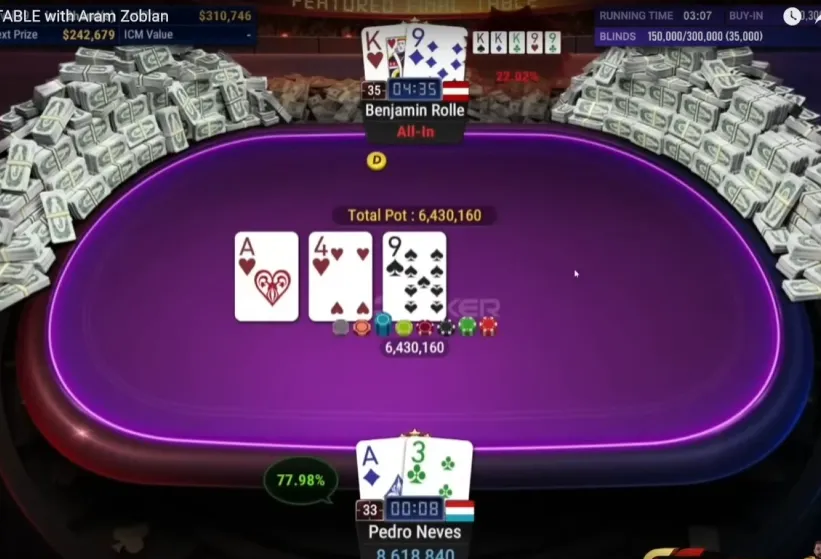
We push 10 big blinds with King–Nine, and we bink the turn. Vamos! Just sunrunning in the preflop all-ins.
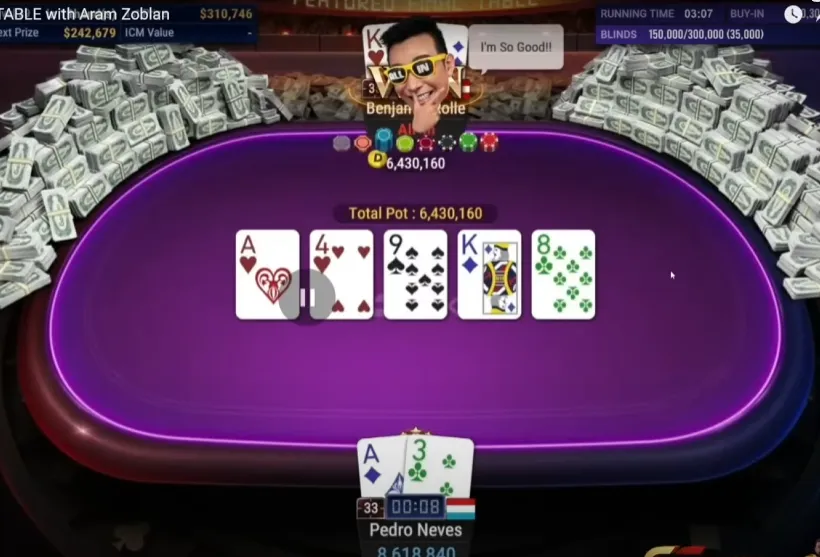
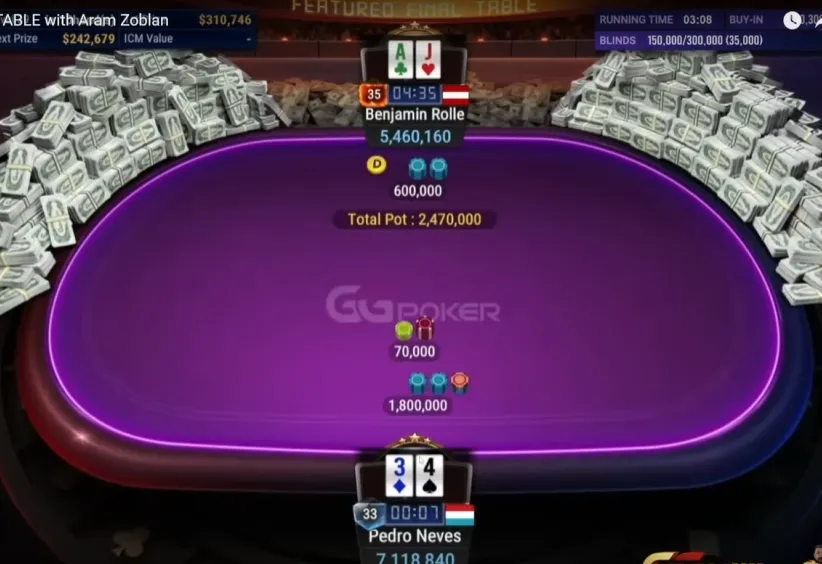
Also here—three-betting the Four–Three offsuit—I wouldn’t mind it if it’s suited. But usually, once you get to 20 big blinds, you want to pick hands like Queen–Three offsuit, King–Deuce offsuit—those kinds of hands.
Queen–Jack—we could jam, but again, plays very well postflop. Raising is awkward.
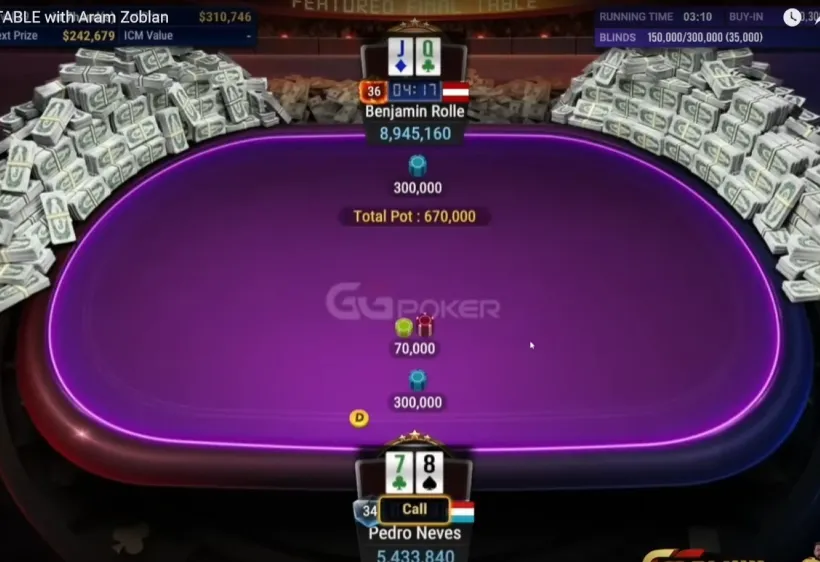
And now he goes for it—and this is also something: I think with a good value hand here, he’d bet closer to pot size. You see he messes up the stack-to-pot ratio a bit. I think it’s more likely he’s saying, “It’s a dynamic board, I have Ace–Queen, King–Jack, Jack–Eight…” You pile it up more to like 1.2–2 million, and then you have almost a pot-size shove left.
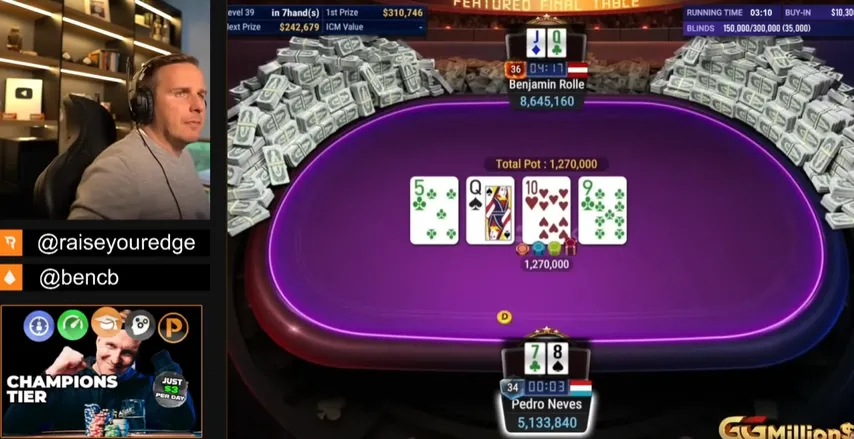
Also here—I’m not sure if I’ve seen his King–Six bluff, probably not. But this is a spot where if he didn’t have so many natural bluffs, I might’ve folded. On a different board, I might fold here. But it’s just very easy to have Seven–Eight, Six–Eight, Jack–Three, Jack–Deuce, Jack–Six, Jack–Seven, King-highs like King–Three with the King of Clubs, and so on.
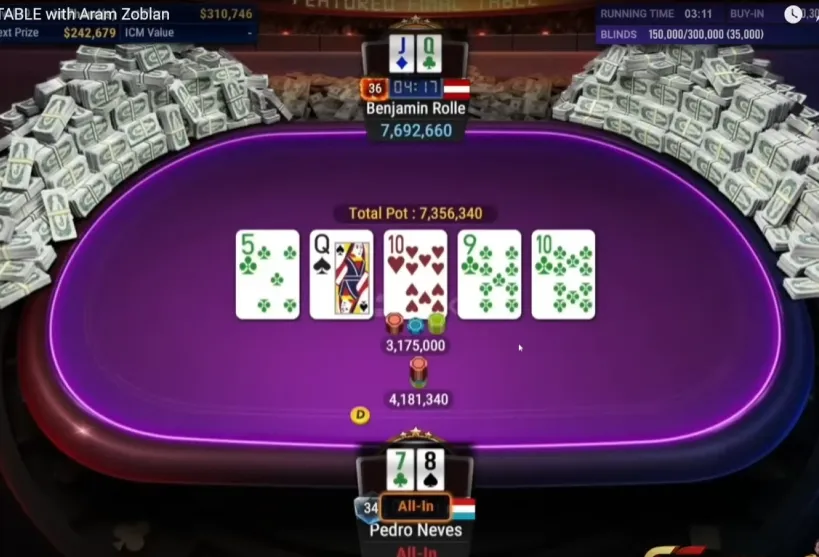
His value is literally only boats, straights, rivered flushes. He’s checking Ten–X on the flop or turn. So lots of potential bluffs.
I know this contradicts my sizing tell, but I’d apply the sizing tell to like 80–90% of spots—where it’s harder to bluff. This is just a spot where it’s easy to bluff, and he overbets all-in.
If I get to the river with top pair, medium kicker—I might make a crazy fold based on that sizing tell. But even those guys, when there are so many bluffs, and maybe they’re a little frustrated—I’m not folding here.
So I decided to make the call. And it’s good to see that I’m still sharp—even after a long final table and being a bit exhausted, because every hand you’re dialing in, thinking it through. It’s more exhausting than grinding for 8 hours, honestly. So much is at stake.
I’m still able to think it through. I have the sizing tell—but I weigh the full situation.
Obviously, you need to win some key pots. You need to sunrun, especially if you’re playing against the best in the world.
So I hope you guys enjoyed that review. There was a lot of value here.







